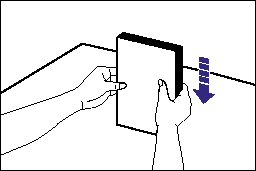Issue
Cause and Solution
Load custom size paper in the multi-purpose tray using the following procedure.
IMPORTANT
Printing speed drops when printing heavy paper.
1. Open the multi-purpose tray, then pull out the auxiliary tray.
2. Spread the paper guides a little wider than the actual paper width.
3. Gently load the stack of paper with the printing side facing up until it touches the back of the tray.
Be sure that the paper stack is loaded under the paper limit guides (A).
IMPORTANT
a. The multi-purpose tray can be loaded with up to the number of sheets listed below.
- Plain paper (64 g/m2): Approx. 125 sheets
- Heavy paper (135 g/m2): Approx. 80 sheets
b. Check that there is sufficient clear space between the paper limit guides and the paper. If there is no free space, slightly reduce the amount of paper.
c. Load the paper so that it is straight.
d. If the rear edge of the paper stack is not properly aligned, it may result in misfeeds or paper jams.
e. If the paper is curled or folded at corners, flatten it before loading it in the printer.
f. If you use paper that has been poorly cut, multiple sheets of paper may be fed at once. In this case, align the edges of the stack on a hard, flat surface.
NOTE
To print letterhead paper or paper printed with a logo, load the paper so that the printing side is facing up, as shown in the following figure.
4. Slide and align the paper guides with both sides of the stack.
IMPORTANT
a. Be sure to align the paper guides with the width of the paper. If the paper guides are too loose or too tight, this may result in misfeeds or paper jams.
b. Do not touch the paper in the multi-purpose tray or pull it out during printing. This may result in a faulty operation.
If you want to print after loading custom size paper in the paper source, you need to register the custom paper size in the printer driver, and then configure the printer driver. For more details, see "How to register a custom paper size (non-standard paper)" in Related Information at the end of this page.
5. Specify the following options in the printer driver.
| Settings Sheet | Settings | Description |
| [Page Setup] Sheet | [Page Size] | Select the paper size of the document created in the application.Select the paper size of the document created by the application. |
| [Output Size] | From [Output Size], select the size of the loaded paper as needed.
Leave the setting at [Match Page Size] when the page size and the size of the paper loaded in the multi-purpose tray are the same, since there is no need to change the setting.
|
|
| [Paper Source] Sheet | [Paper Source] | Select [Multi-purpose Tray].
Specify the same setting as the one for [Paper Source], although the setting for [Paper Source] changes to ones such as [First Page] or [Other Pages] when other than [Same Paper for All Pages] is selected for [Paper Selection].
|
|
| [Paper Type] |
Select the paper type of the loaded paper.
Select [Plain Paper] for plain paper and [Heavy Paper] for heavy paper.
|
|
IMPORTANT
When the settings for [Page Size] and [Output Size] are different from each other, the scale factor is adjusted automatically.
NOTE
"User's Guide" (PDF manual) on the CD-ROM supplied with the printer provides explanations on using the features of the printer and printer driver. By specifying the settings for the printer and printer driver for each job, you can make the best use of the printer and its functions.






